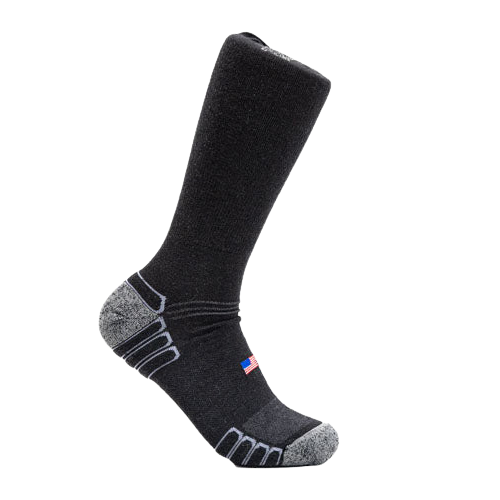The longer a product is around, the more comfortable people are with it.
They know what they’re getting and often don’t like change.
Steel toe boots have been around since the 1940s, and they’ve repeatedly proven that they work. While relatively new comp toe is quickly becoming just as popular, how do you know they’re as safe as steel toe?
After researching comp toe boots, I’ve found they can be just as safe as a steel toe, though it depends on where you’re working as to whether one will benefit you over the other.
Read on to see where a comp toe could be the way to go and where a steel toe will always be the best choice.
Comp Toe vs Steel Toe: Which Should You Go For?

Protecting your feet while at work should always be a top priority, and for the last 80 years, the safest option has always been a steel toe boot. When your choice is between steel toe and no toe, there’s really not much of a choice.
Since the introduction of comp toe boots, your options have changed massively.
Comp toe boots used to be much more expensive, which made choosing one boot over another a lot easier. That cost has now dropped to where a comp toe boot won’t cost much more than a steel toe.
Because both types of safety toe offer comparable protection for your toes, it’s the smaller details that makes the difference. Different materials bring different advantages and drawbacks, such as weight, thickness, and conductivity.
I wanted to show you the benefits and drawbacks of a comp toe boot and a steel toe boot. Once you know what each offers, you can choose the right safety toe for your needs.
What Is a Comp Toe?
Don’t mistake composite materials for meaning “made of plastic” because comp toe boots are made of some of the toughest, most innovative materials ever designed.
You’ll not be buying boots made of recycled soda bottles, there’s more chance they’ll use the same materials a Formula 1 car is made of, and they keep drivers safe in crashes of 300kph.
It could even be a comp toe made of kevlar, and that stuff stops bullets, let alone the house brick you just dropped on your foot.
My point is, don’t get hung up on the material—the features, benefits, and drawbacks of a comp toe will make your decision for you.
Benefits of a Comp Toe
Unlike steel, a composite toe won’t conduct heat or cold, making it a superb option if you’re working in extreme weather.
Steel will absorb the cold if the temperature plummets, slowly transmitting it to your toes. Comp toe boots won’t be affected by the cold, and it’s the same for heat.
If you’ve ever touched a metal handrail that’s been in direct sunlight, you’ll know how hot it can get. Comp toe boots won’t cook your feet like steel can.
Regulating the temperature of your feet makes working in harsh weather a lot easier, so I always wear the Camel City Mill Boot Wool Work Sock.

Its thermoregulated design means my feet stay at a steady temperature, and as my comp toe boots won’t transmit heat or cold into my boot, my feet stay as warm as I need them.
Another great benefit of choosing a comp toe boot is the weight. Carbon fiber, fiberglass, and kevlar are commonly used in comp toe and are much lighter than steel.
If you suffer from foot fatigue or plantar fasciitis, a comp toe could be perfect for you. Every ounce of weight you save starts to add up after a 12-hour shift on your feet.
Being non-metallic, a comp toe boot can go places a steel toe boot can’t.
If you’re in a job where you’re dealing with security measures, a comp toe boot is a perfect choice because metal detectors aren’t set off by a composite toe.
Drawbacks of a Comp Toe
The biggest drawback to a comp toe boot is that it can’t take the repeated abuse that a steel toe can. Once your comp toe boot has taken damage, there’s a higher chance that it loses integrity to the point it won’t protect your foot.
A steel toe can be scratched, squashed, and maintain its shape and protective qualities. A comp toe “might” be okay. And that unanswered question might lead to you needing new boots.
The other drawback of a comp toe is that some work sites will demand a steel toe safety boot. If that’s possible where you work, you’ll have to wear a steel toe boot.
As for looks, a comp toe often looks bulkier than a steel toe, as the composite materials are thicker to offer a similar level of protection. It’s not a huge difference, but the toe box of a comp toe does look chunkier than its steel counterpart.
As steel toe and comp toe are tested to the same standards and meet the same regulatory specifications, it’s a pain, but some employers will clearly state that steel toe boots are required.
Are Steel Toe Boots Better than Comp Toe?

Steel toe boots are a proven winner if you’re after reliable work boots that offer absolute protection.
If you’re not working around metal detectors or in extremes of heat or cold, or if you just prefer to stick with what you know, steel toe boots won’t let you down.
However, like a comp toe boot, a steel toe has both benefits and drawbacks.
There’s no right or wrong answer to which is the better option. It’s all down to why you need safety boots and where you’ll wear them.
Benefits of a Steel Toe
As a general rule, steel toe boots are slightly cheaper than comp toe but offer your feet protection that’s hard to match. If I had to put my safety on the line right now, I’d choose steel toe.
Because steel is a strong material, you’ll usually find a steel toe boot looks less bulky than a comp toe boot. The steel toe is thinner, making for a more streamlined boot. That narrower toe might feel more comfortable if you’re up and down ladders or telegraph poles.
Unlike a comp toe boot, if your steel toe takes a sudden, heavy impact unless your boots are ruined, you can wear them again. After the same impact on comp toe, there’s no guarantee the structure has remained safety rated.
Another obvious benefit of steel toe boots is that they are more readily available than comp toes. While composite is quickly catching up, you can find a steel toe safety boot in any style or brand you like.
Drawbacks of a Steel Toe
Working outside on a hot summer’s day will soon have your feet cooking in steel toe boots. The hotter the day, the more the steel absorbs the heat.
The steel toe can act as a hotplate, especially if you’ve worn down the front of your boots, showing the steel. The same can be said about the cold—steel sucks in the cold and quietly goes about freezing your toes.
If you’re working around live electricity, steel toe boots aren’t even close to being as good as a comp toe. The same goes for working in security zones like airports, where your steel toe will set off alarms.
While a comp toe boot is a little more expensive, it can do everything a steel toe can, while in certain conditions, a steel toe boot can no longer say the same.
Conclusion
The difference in the level of safety you’ll get between a steel toe boot compared to a comp toe boot is slight. The only time you’d choose a steel toe specifically is if you’re on a work site that demands it.
Until I had really looked into what a comp toe boot can do, I would have always chosen a steel toe purely because I know the protection they provide is excellent.
A comp toe has clear advantages for electrical work, security jobs, or working in extreme cold or heat. For anything else, the choice is yours. Steel toe boots will probably never go out of fashion.
If it ain’t broke, right?






